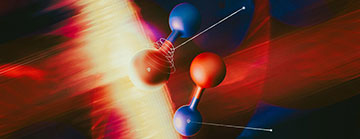
[Image: SLAC]
The photoelectric effect is not truly instantaneous―a time delay exists between a molecule absorbing a photon of light and emitting an electron. This photoemission delay, up to a few hundred attoseconds in duration, has only recently been accessible to experimental science with the advent of attosecond-length light pulses. The first measurements of the photoemission delay were performed using light in the ultraviolet wavelength regime.
Now, an international team of researchers has demonstrated the first measurement of attosecond photoemission delays at X-ray wavelengths (Nature, doi: 10.1038/s41586-024-07771-9). The delays reached up to 700 attoseconds—significantly longer than previously predicted—suggesting that several effects not included in present models of X-ray photoemission are contributing to a mismatch in results.
“Measuring the photoemission delay teaches us valuable information about the role of electron correlation—how electrons interact with each other in many-electron systems,” said study author Taran Driver, SLAC National Accelerator Laboratory, USA. “The physics of electron correlation is extraordinarily complex and understanding how it works will be important to driving the development of new technologies.”
Attosecond X-ray pulses
The photoelectric effect is a multi-electron process, since the removal of even one electron causes the electronic wave function of the residual ion to rearrange itself. Particularly of interest is the removal of core-level electrons, but the required X-ray photon energies were not previously available with attosecond tabletop sources.
The current study was enabled by the attosecond mode of SLAC’s Linac Coherent Light Source (LCLS), an X-ray free-electron laser that uniquely combines high-intensity, high-photon energy with short pulse duration. Driver and his colleagues used an attosecond X-ray pulse tuned to approximately 540 to 580 eV to ionize a core-level electron from the oxygen K-shell of nitric oxide.
“We sought to make the first measurement of the photoemission delay in the X-ray regime and so learn more about the fundamentals of how X-rays interact with matter, where photoionization is one of the dominant interactions,” said study author James Cryan, SLAC. “[The LCLS] was the first place in the world where it was possible to make isolated attosecond X-ray pulses, which are a prerequisite for being able to access the extreme timescales associated with the X-ray photoemission delay.”
Probing electron correlations
The researchers then leveraged a technique called attosecond angular streaking, an approach for achieving attosecond time resolution, to measure the photoemission delay. The X-ray pulse overlaps with a circularly polarized infrared laser field, which maps the temporal profile of the X-ray photoemission to the final momentum of the electron. The photoemission delay is then determined with high precision by measuring the angular difference in the direction of the ejected electrons.
They also found evidence of post-collisional interaction involving Auger-Meitner electrons emitted by core-ionized molecules.
The delays measured larger than expected, up to 700 attoseconds. The researchers suggested several possible reasons for this, including the fact that core electrons are very sensitive to electron correlation effects, which cause an especially large increase in time delay. They also found evidence of post-collisional interaction involving Auger-Meitner electrons emitted by core-ionized molecules.
“In making these measurements, we are developing new experimental ways to probe electron correlation in real-world systems,” said Driver. “Electron correlation is critical for defining and tuning the fundamental properties of matter, and a better understanding of this ubiquitous phenomenon will ultimately help us gain a deeper understanding of important biochemical reactions and choose new materials for next-generation electronics.”
